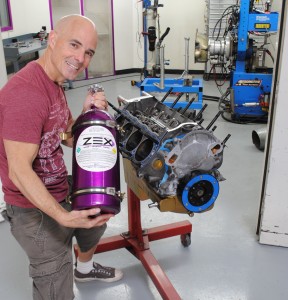Words And Photos: Richard Holdener
What’s not to love about nitrous oxide? If you are a car guy (or gal), you owe it to yourself to install nitrous on at least one car, any car, before you trade in that hot rod for the inevitable mini van. Why is nitrous cool, you ask? Where else can you get instant power at the push of a button? The great thing about nitrous is that not only can you get that big hit but the hit can be applied to just about ANY combination, from stock to Super Stock. Nitrous doesn’t care what name is plastered on the outside of your car, it just needs injection into an internal combustion engine and the compound will do the rest. It is for this reason that nitrous oxide is so popular among racers. As a street racer, how do you not just love the fact that you have an extra 100-500 hp (or more) at the push of a button? Talk about instant gratification! Before we get to the specific benefits of the ZEX Perimeter Plate and results of our dyno test, we should take a quick look at the amazing compound known as nitrous oxide.
There is much to learn about nitrous oxide, but here are a couple of fun facts that everyone should know. First and foremost, nitrous oxide is not flammable-it doesn’t blow up in spectacular fashion as depicted in the movies. This is because nitrous oxide is an oxidizing agent and not a fuel. While it can greatly increase the power output of your motor, your motor could not run on nitrous oxide alone. Touching a match or even a torch to the stream of nitrous oxide will result in little more than the fire being put out. There will be no huge explosions and no fireballs unless of course, the liquid nitrous has been augmented with C4 and a suitable detonator.
Second up is the fact that releasing the power-producing oxygen molecules in the dinitrogen monoxide compound requires heating to approximately 572 degress. This happens during the combustion process. Once the oxygen molecules are free, they can enhance burning of the additional fuel supplied and viola, you have extra power. As an added benefit, the nitrous oxide is stored in liquid form then supplied to the motor as a gas (a process call vaporization). Since the boiling point of nitrous oxide is -129 degrees, nitrous greatly decreases the inlet air temp to further improve power and reduce the possibility of harmful detonation.
Though it is all the rage in movies and on TV, nitrous oxide is not new. In fact, it was first obtained by Joseph Priestly way back in the late 1700’s, then used as an anesthetic in the early 1800s. Development for nitrous oxide as a performance enhancement literally took off during World War II as both the Germans and British sought ways to improve the air speed and effective altitude limits of their war-time aircraft. There is little better motivation for development than actually saving lives. The higher a plane flies, the less oxygen present in the air. The lack of oxygen greatly reduces the power production of the motor, limiting both speed and maximum altitude potential. Nitrous oxide carried the additional oxygen in chemical form that was put to use to augment the then-current forms of mechanical supercharging. According to the limited available data, the power gains employed by both the British and Germans during World War II ranged from 600 additional horsepower on the British Mosquito bombers to as much as 1,000 additional horsepower on the German JU 188 reconnaissance planes.
With the brief history and technical explanation of nitrous oxide out of the way, we can now take a look at the specific benefits offered by the ZEX Perimeter Plate system. According to ZEX(perts), the Perimeter Plate configuration offered a number of beneficial design features including Perimeter Injection, Cryo-Sync and Airflow Enhancement Technology. While nitrous oxide has the potential to offer tremendous power gains, it is critical to have even distribution among the cylinders. Unlike a typical single, wet-fogger system employed in the inlet tract of an EFI application or spray-bar system on a carbureted motor, the Perimeter Injection was designed to optimize cylinder-to-cylinder distribution.
The carbureted plate system employed 12 (equidistant) injection points that combined nitrous and fuel to optimize not only atomization (very important), but also distribution in the manifold. As you might imagine, injecting super-cool nitrous (at -127 degrees) through the plate (sandwiched between the car and intake) effectively turned it into a Cryo-Sync (or heat isolator) to help cool both the intake and carburetor. In addition, the high-pressure flow of nitrous and fuel through the spacer plate and into the manifold also worked to create a low-pressure zone to further enhance airflow into the motor. So far, the Perimeter Plate system sounded impressive, but would these on-paper benefits carry over to actual results on the dyno?
Obviously there was only one way to answer that question, we had to put the system to the test on the dyno. Before we could do that, we needed a suitable test motor, one capable of swallowing a healthy dose of ZEX Perimeter-Plate nitrous. Ensuring plenty of strength was a Dart SHP short block that included 4-bolt, 4.125-bore block packed full of forged components. The rotating assembly included a 4340-forged (3.40-inch) Scat crank, matching 5.40-inch rods and a set of Mahle flat-top pistons. To ensure plenty of power production, the short block was augmented with a custom cam from Cam Research Corporation. The solid roller profile featured .736-lift (in & ex), a 256/260-degree duration split and tight 105-degree LSA. COMP Cams supplied the necessary solid roller lifters, double roller timing chain and Gold 1.6-ratio roller rockers. The SHP short block was topped off with a set of Dart Pro 1 225 CNC heads, Speedmaster Funnel-Web intake and Holley 950 HP carb. Also present was a complete MSD ignition, Hooker Super Comp headers and Meziere electric water pump.
The test procedure was a simple one. We would start by running the 363 stroker in normally aspirated trim, then add some ZEX Appeal with a 200-hp shot of nitrous from the Perimeter Plate system. Even without the nitrous, the test mule was no slouch, offering a power peak of 563 hp at 6,700 rpm. Not to be out done, the peak torque checked in at 487 lb-ft of torque at 5,200 rpm. The torque production from the big-bore stroker exceeded 450 lb-ft from 4,300 rpm to 6,500 rpm. We prepped the ZEX kit by installing jetting to supply 200 horsepower, then heated the bottle to optimize pressure at 900 psi.
In anticipation of the extra 200 hp, we retarded the ignition timing by eight degrees. Boy howdy did this nitrous injected combination show some ZEX Appeal, as the peak numbers jumped to 775 hp and 727 lb-ft. The graph illustrates a sizable spike in the torque curve (typical of nitrous), followed by a solid increase in power as long as you held down the button. There must be something to the Cryo-Sync, Airflow Enhancement and Perimeter Injection as the ZEX kit exceeded the advertised power rating on our carbureted stroker. Pumping out 775 hp, this was one small-block Ford with serious ZEX Appeal.
As is evident by the graph, the ZEX Perimeter Plate nitrous system offered some serious power. The plenty potent 363 Dart stroker produced 563 hp and 487 lb-ft of torque but these peak numbers quickly jumped to 775 hp and 727 lb-ft with the nitrous. Since the power offered by nitrous is based on bottle pressure and orifice (jet) size, the horsepower gains stay consistent regardless of engine speed. This means that activating a 200-hp shot below 5,252 rpm will result in substantially more torque. Care must be taken to keep engine speed at a reasonable level before hitting the button, as the tremendous (instantaneous) torque can damage components not designed for the additional strain. Applied properly, the ZEX Perimeter Plate system can safely add as much 300 extra horsepower.
Sources
Aeromotive
aeromotiveinc.com
COMP Cams
compcams.com
Dart Machinery
dartheads.com
Holley/Hooker
holley.com
Speedmaster
speedmaster.com
ZEX Nitrous
zex.com



























